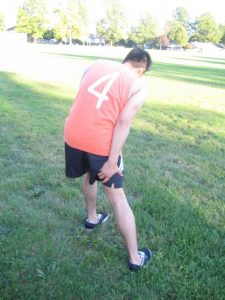Thigh pain happens due to injuries caused to the thigh which are usually acute injuries.
Thigh pain happens at the rear of the thigh as in a hamstring strain or at the front with quadricep muscle strain. Three groups of muscles in the thigh that causes pain includes the hamstring muscles found at the rear region of the thigh, the quadricep muscles at the front aspect of the thigh as well as the adductor muscles found in the inner thigh. The hamstring and the quadricep are more susceptible to strains because they cross the hip and the joint of the knee which functions in straightening and bending the legs. These can be injured in jumping, running and other sports.
Symptoms of thigh pain

- Throbbing pain
- Feel dull and achy
- Piercing or tingling sensations
- “pins and needles “sensations
- Prickling or burning
- Incapable of putting weight on the leg and difficulty in walking
Treatment
- Take plenty of rest especially the affected area. avoid performing activities that causes pain to prevent further damage. Rest the thigh for at least one or two days for fast healing of the condition.
- Apply ice pack on the injured thigh for proper flow of blood in the area and lessen the pain. It also lessens the inflammation and the swelling. Apply ice on the area for at least 10-15 minutes at a time every hour on the first 24 hours after the injury except when sleeping. After the first 24 hours reapply ice 4-5 times throughout the day every 2-3 hours. Avoid ice directly on the skin. Wrap ice using a towel or a cloth before placing to the area to prevent ice burn and worsen the condition. Another alternative is using bags of frozen vegetables such as corn or peas is good for the condition.
- Wrap the affected area using compression bandage or a compression shorts to lessen the swelling and support the injured area. avoid wrapping the compression bandage too snugly to prevent issues with circulation.
- Raise the affected leg higher than the level of the heart to lessen the swelling. If there is difficulty raising the leg, keep it parallel to the ground.
- Take the prescribed over-the-counter pain medication such as ibuprofen or acetaminophen to lessen the inflammation and the pain.
- After 48-72 hours apply heat on the area to lessen the soreness and the tightness of the muscles and increase flow of blood in the area. avoid applying heat on a fresh injury or severe pain. Apply heat on the area for at least 15 minutes, 3-4 times every day. Heat can be in the form of a heating pad, warm compress, a heated wrap or a hot water bottle. Another alternative is soaking the body in a hot bath.
- After using the thigh without pain apply alternately hot and cold compress to lessen the pain and the swelling. Apply heat for at least 2 minutes and then follow it with a 1 minute of cold compress. Repeat this process at least 6 times, twice every day.
Disclaimer / More Information
The material posted on this page on thigh pain is for learning purposes only. Learn more about the causes by taking a first aid and CPR class with one of our training providers.
FACT CHECK
https://www.healthline.com/health/pain-in-upper-thigh
https://www.medicalnewstoday.com/articles/321001.php
https://www.webmd.com/pain-management/ss/slideshow-leg-pain-causes

